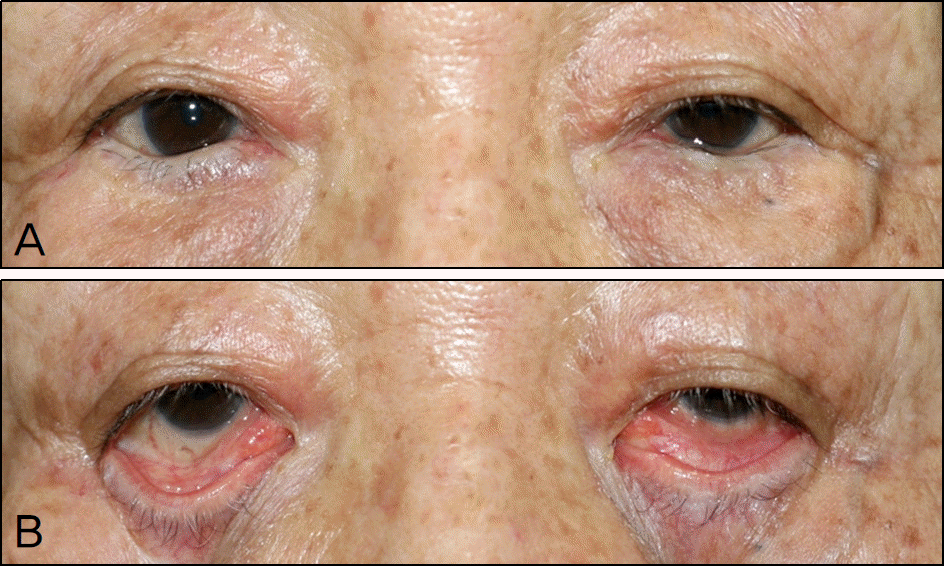Abstract
Purpose
To report the clinical features and surgical results for lower lid entropion with kinked tarsus compared with entropion with weakened capsulopalpebral fascia.
Methods
From March 2008 to December 2009, 20 patients (24 eyes) with lower lid entropion were examined. The patients were divided into the aggravated entropion with kinked tarsus group or the weakened capsulopalpebral fascia group based on the height of tarsus, the shapes of the lower lid and tarsus, and conjunctiva changes. For treatment of entropion in the kinked tarsus group, full thickness tarsotomy with rotatory suture (tarsal fracture operation) was performed, and in the weakened CPF group, a CPF tight procedure was performed. The results of the operations were retrospectively evaluated.
Results
The mean age of the patients with entropion in the kinked tarsus group (15 cases) was 66.7 ± 11.4 years, and the mean age of the patients with entropion in the weakened CPF group (9 cases) was 67.2 ± 6.2 years. The height of the lower lid tarsus of each group was 3.80 ± 0.39 mm and 5.20 ± 0.30 mm, respectively. Except for one case of recurrence after tarsal fracture operation in the kinked tarsus group and reoperation with CPF tightening, there were no significant complications or recurrence in either group.
Go to : 
References
1. Dalgleish R, Smith JL. Mechanics and histology of senile entropion. Br J Ophthalmol. 1966; 50:79–91.

2. Dryden RM, Leibsohn J, Wobig J. Senile entropion. Pathogenesis and treatment. Arch Ophthalmol. 1978; 96:1883–5.
3. Hong SH, Woo KI, Chang HR. Transconjunctival repair for involutional entropion. J Korean Ophthalmol Soc. 2002; 43:2095–100.
4. Kang SU, Lee SY, Kim HB. Correction of senile entropion by full thickness lid excision. J Korean Ophthalmol Soc. 1990; 31:9–12.
5. Barnes JA, Bunce C, Olver JM. Simple effective surgery for involutional entropion suitable for the general ophthalmologist. Ophthalmology. 2006; 113:92–6.

6. Baek SH, Bae JY. The effect of single suture inferior retractor tightening for the effect of single suture inferior retractor tightening for senile entropion. J Korean Ophthalmol Soc. 2004; 45:1215–20.
7. Kim JY, Kim YD. Surgical correction of senile entropion. J Korean Ophthalmol Soc. 1992; 33:1015–20.
8. Bashour M, Harvey J. Causes of involutional ectropion and entropion-age related tarsal changes are the key. Ophthal Plast Reconstr Surg. 2000; 16:131–41.
9. Yun JK, Shim JC, Lee JH, et al. Surgical results of inferior tarsotomy for diffuse lower lid trichiasis. J Korean Ophthalmol Soc. 2002; 43:1123–7.
10. Nerad JA. The diagnosis and treatment of entropion. Krachmer JH, editor. Oculoplastic Surgery, the Requisites in Ophthalmology. St. Louis: Mosby;2001. chap. 4.
11. Smith BC. Entroion. Nesi FA, Lisman RD, Levine MR, editors. Ophthalmic Plastic and Reconstructive Surgery. 2nd ed.St. Louise: Mosby;1998. chap. 12.
12. Swamy BN, Benger R, Taylor S. Cicatricial entropion repair with hard palate mucous membrane graft: surgical technique and outcomes. Clin Experiment Ophthalmol. 2008; 36:348–52.

13. Bleyen I, Dolman PJ. The Wies procedure for management of trichiasis or cicatricial entropion of either upper or lower eyelids. Br J Ophthalmol. 2009; 93:1612–5.

14. Sisler HA, Labay FR, Finlay JR. Senile ectropion and entropion: a comparaive histopathological sutdy. Ann Ophthalmol. 1976; 8:319–22.
15. Kim SY, Shin SJ, Yang SW, et al. Microscopic anatomy of the lower eyelid in Koreans. J Korean Ophthalmol Soc. 2006; 47:292–6.
16. Siegel RJ. Involutional entropion: a simple and stable repar. Plast Reconstr Surg. 1988; 82:42–7.
Go to : 
 | Figure 1.Entropion with kinked tarsus of the left lower eyelid in a 66 year old male patient. (A) Left lower eyelid with severe entropion and inferior cornea cilia touch. (B) Left lower eyelid with kinked tarsus and traction. (C) Entropion with kinked tarsal plate and conjunctival grooving was found upon eversion along with a blunt lid margin and conjunctival injection on slit lamp exam. |
 | Figure 2.Entropion of both lower eyelids with kinked tarsus in the left lower eyelid and weakened capsulopalpebral fascia in the right lower eyelid in a 77 year old female patient. (A) Entropion was found on both lower eyelids without traction and the cilia of the left lower eyelid appeared more inverted than the right. (B) Lower eyelid traction test with equal power was done on both lower eyelids. Entropion with kinked tarsus was found in the left lower eyelid and entropion with weakened capsulopalpebral fascia in the right lower eyelid. Signs of severe conjunctival injection, chemosis, and blepharitis were found to be more prominent in the left eye versus the right eye. |
Table 1.
Demographics and clinical characteristics of Senile entropion†
| Entropion with kinked tarsus | Entropion with weakened CPF* | |
|---|---|---|
| Age (mean ± SD, yr) | 66.7 ± 11.4 (47–86) | 67.2 ± 6.2 (59–76) |
| Sex | ||
| M:F (eye) | 6:7 (8:7) | 3:5 (3:6) |
| Eye | ||
| OD (eye) | 6 | 4 |
| OS (eye) | 9 | 5 |
| Follow up (mean ± SD, mon) | 2.87 ± 2.03 (1–6) | 3.00 ± 2.29 (1–6) |
| Height of inferior tarsus (mean ± SD, mm) | 3.80 ± 0.39 (3.0–4.3) | 5.20 ± 0.30 (4.6–5.5) |
| Recurrence of entropion (eye) | 1† | 0 |




 PDF
PDF ePub
ePub Citation
Citation Print
Print


 XML Download
XML Download